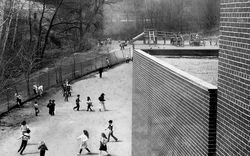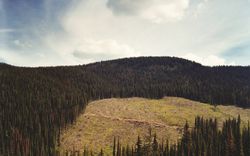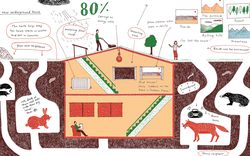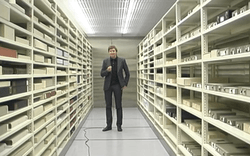Glimpses of Nuclear Ontario
Photographs by Robert Del Tredici. Texts by Robert Del Tredici and Gordon Edwards
Eighteen thousand people live in picturesque Port Hope on the north shore of Lake Ontario, an hour’s drive from Toronto. The town is host to one of the oldest and largest uranium chemical processing facilities on the planet, located not far from the downtown shopping district. In the background of the image above are the two key uranium conversion facilities: the smaller structure, on the left, processes uranium for domestic use; the larger building, on the right, processes uranium for exports worldwide.
The Cameco Uranium Conversion Plant began its life in 1932 as a radium refinery. In 1942 it started refining uranium for the Manhattan Project. During these years, the refinery dumped radioactive waste directly into the adjacent harbour, where the Port Hope Yacht Club still moors its leisure craft. Uranium continued to be processed at Port Hope for the US nuclear weapons program until 1965.
Uranium mined in Saskatchewan is first processed in northern Ontario’s Blind River refinery, where it is turned into uranium trioxide gel. The gel is then shipped to Port Hope, where it is chemically converted into other uranium compounds. Uranium dioxide (15 percent of Cameco’s output) is produced in the building on the left; it is later fabricated into fuel rods for domestic use. In the larger building on the right, uranium hexafluoride (85 percent of Cameco’s output) is produced for export. The hexafluoride is shipped to enrichment plants that produce low-enriched uranium (LEU) for fuel in light-water reactors throughout the world, and highly enriched uranium (HEU) that can be used for nuclear submarine fuel, medical isotope production, and nuclear weapons.
St. Mary’s Elementary School had to be evacuated in 1975 when radioactive radon gas was detected inside. Radon levels in the cafeteria were higher than the limits allowed in an underground uranium mine. This was because the radioactive gas was being continually generated by radium-bearing sandy wastes that had been used as fill in the school playground and around the school’s foundations. The local uranium refinery had made these radioactive materials freely available to Port Hope’s citizens in the late 1950s.
In 1975, the contaminated material around St. Mary’s School was excavated and trucked to a local radioactive dump. Today, one of the most expensive municipal environmental cleanups in Canadian history is underway in Port Hope as radioactive wastes have been identified at hundreds of properties and in local ravines. Over one million cubic metres of material have been located so far. The wastes will be collected, repackaged, transported, and stored in an engineered long-term facility just north of the town, in the village of Welcome. The project also calls for dredging the harbour to recover much of its radioactive sediment. This cleanup is a joint venture between the Canadian federal government and the town of Port Hope, at the estimated cost of $1.2 billion.
Read more
This staging area for the sorting of Port Hope’s radioactive wastes began as the Monkey Mountain Waste Dump in 1945. The site was named “Monkey Mountain” because a circus train had derailed close by and monkeys escaped, populating a wooded hill in this location for several years. Later on, Monkey Mountain was used as a dump for residues from refining operations; these wastes included arsenic, uranium, and radium. The site was poorly maintained for decades and it plagued its neighbours with toxic and radioactive run-off, and high levels of gamma radiation at the fence line.
The original Monkey Mountain site is now a grassy field located one hundred metres from this mound, and its wastes were gradually moved to other sites such as the Cameco Plant, Chalk River, the old Welcome Waste Dump, and the Port Granby Dump.
After being closed for decades, the Monkey Mountain area became a temporary home to some two hundred thousand cubic metres of radioactive wastes from Port Hope. These are now stored in five contiguous sites. The mound in the photo is known as Pad I and it contains six thousand cubic metres of waste. Since this photo was taken, another mound with another six thousand cubic metres of waste (Pad II) was added next door. In addition, the Monkey Mountain area is adjacent to the Highland Drive Landfill Site, with fifty thousand cubic metres of waste, and the Pine Street Extension Road Bed, with a road made from seven thousand cubic metres of radioactive tailings. This cluster of dumps is within walking distance of the Port Hope High School.
A total of about two hundred thousand cubic metres of waste await storage in a new Port Hope long-term waste management facility located nearby, in elevated wetlands near Welcome. The long-term facility has been designed to manage the wastes for five hundred years. These are wastes that will remain radioactive for tens of thousands of years.
The Bruce Nuclear Complex is the largest operating nuclear-generating station in the world. Located on the shore of Lake Huron, it contains nine reactors, eight of them at the Bruce site and one at nearby Douglas Point. The Bruce site also contains a heavy water plant (now closed) and a low-level radioactive waste incinerator. It is also the site of the Western Waste Management Facility, which stores all the low- and intermediate-level radioactive wastes from Ontario’s twenty reactors, as well as the irradiated nuclear fuel from the Bruce reactors.
A Deep Geologic Repository (DGR) is planned for this site but has not yet received final approval. This would be a permanent underground repository for all of Ontario’s reactor wastes, except for irradiated fuel, and it would be located less than a mile from the shoreline of Lake Huron. Ontario Power Generation (OPG) states in its Environmental Impact Statement for the DGR that there will be four phases to the project: (1) construction of the DGR; (2) emplacement of the wastes; (3) closure of the DGR; and (4) abandonment of the wastes. As phase 4 approaches, the Canadian Nuclear Safety Commission intends to give OPG a License to Abandon. The proposed location of the DGR right beside the Great Lakes has elicited furious protests on both sides of the border, especially since no other site has been considered. Recently, Canadian minister of environment Catherine McKenna has withheld final approval and insisted that OPG study alternative locations away from the Great Lakes.
In 2011 the Bruce complex received approval to ship sixteen of its radioactive steam generators (or “nuclear boilers”) through the Great Lakes and along the St. Lawrence Seaway to Sweden. Each boiler, weighing one hundred tons, has been permanently contaminated with dozens of radioactive elements, including plutonium. Studsvik planned to recycle some of the radioactive steel into commercial products. There were no plans for labelling to indicate that those products contain radioactive materials.
The shipment of sixteen would have eventually been followed by over one hundred additional boilers. The initial shipment, however, was stopped by protests in the United States and Canada. Resolutions against the shipment were passed by four hundred Quebec municipalities including Quebec City and Montreal. The Mohawk First Nation in Kahnawake also played a key role in blocking the shipment by refusing to allow the radioactive boilers passage through the portion of the St. Lawrence that flows through its territory.
This burial ground is part of the Western Waste Management Facility at the Bruce Nuclear Complex. It contains heat exchangers that have become contaminated with radioactive materials, typically cesium-137, from routine reactor operations. Because these heat exchangers cannot be recycled, they have been seal-welded, coal-tarred, and buried in limestone at this site. Once a year they are tested for possible leakage. Since the half-life of cesium-137 is thirty years, monitoring will be needed for several centuries.
These concrete silos contain the entire inventory of irradiated nuclear fuel from the Douglas Point reactor, Canada’s first full-scale CANDU (CANada Deuterium Uranium) reactor, which was designed to generate 220 megawatts of electrical power. Part of the Bruce Nuclear Complex, the Douglas Point reactor is located in Kincardine on the shore of Lake Huron.
In the 1960s, Canada sold two copies of the Douglas Point reactor to India, with financing to be repaid over fifty years without interest. When India built and exploded its first atomic bomb, nicknamed “The Smiling Buddha,” in 1973, the plutonium came from another reactor that Canada had given as a gift in 1956. Although Canada immediately ended all nuclear cooperation, India went on to build sixteen additional reactors based on the Douglas Point design.
The Douglas Point reactor was shut down in 1984 but it has been only partly decommissioned. Ontario Hydro says it will wait fifty to one hundred years before dismantling the reactor’s most radioactive internal structures. There are currently no sites in Canada suitable to receive such wastes, which require safe storage for millennia.
Unlike most reactors, CANDU designs do not hold nuclear fuel in a single vessel; they use hundreds of individual pressure tubes that hold eight to twelve fuel bundles each. This means a CANDU can be refuelled one tube at a time without shutting down, a feature that is known as “on-line refuelling.” This makes for more efficient energy production and it also makes it more difficult to determine if irradiated fuel has been clandestinely removed from a CANDU for its plutonium. This feature has made CANDUs attractive to states interested in developing nuclear weapons. There are twenty-five CANDUs in Canada: twenty-two in Ontario (four of them closed), two in Quebec (both closed), and one in New Brunswick (operating).
The decision to build Canada’s first reactor was made in Washington, DC, in 1944 as part of the effort to produce plutonium for nuclear weapons. Canada’s reactors use unenriched (“natural”) uranium as fuel, with a moderator of heavy water, to produce neutrons, heat, steam, electricity—and plutonium. In fact, CANDUs produce about twice as much plutonium as any other reactor except “breeder” reactors, which are designed expressly to produce plutonium. This is why Canadian nuclear scientists sometimes refer to the CANDU as a “near breeder.”
In addition to India, Pakistan, Argentina, South Korea, Romania, and China have operating CANDUs.
These plastic drums hold mixed chemical and radioactive wastes left over from operations at the Blind River uranium refinery, which has been processing uranium ore since 1983. The cocktail includes radium, thorium, radon, and polonium. Plant workers call these wastes “crud” and refer to the plant’s refined uranium product as “OK liquor.” The “OK liquor” is uranium trioxide gel; it is shipped in drums to Port Hope, where it is converted into uranium dioxide or uranium hexafluoride.
The ten-metre-high wall of white sandy material behind the trees is made of radioactive wastes called uranium mill tailings. The tailings come from nearby uranium mines and mills. Behind the wall is an entire lake filled with seventy million tons of the same radioactive sand. The site is unfenced and unguarded. These wastes are leftovers from postwar military contracts with the US army, which used Canadian uranium in tens of thousands of its nuclear weapons.
Uranium mill tailings contain many of the most dangerous radioactive materials found in nature: radium, radon, thorium, polonium, and radioactive lead—all by-products of uranium refining. Some of these radioactive materials are short lived, like Radon gas, but they are continually replenished by the disintegration of other materials, some of which take millennia to decay.
In the mid-1970s, decades of runoff from these and other tailings in the region were found to have seriously contaminated the entire ninety-three kilometres of the Serpent River system, with its eighteen lakes, before discharging into Georgian Bay. Mitigation efforts have been undertaken since this photograph was taken, but the tailings will remain hazardous for hundreds of thousands of years, during which time they will require perpetual monitoring. In all, Canada currently has 225 million tons of uranium mill tailings. This amount increases every year.
A selection of these photographs appears in our 2016 exhibition and publication It’s All Happening So Fast: A Counter-History of the Modern Canadian Environment.






















